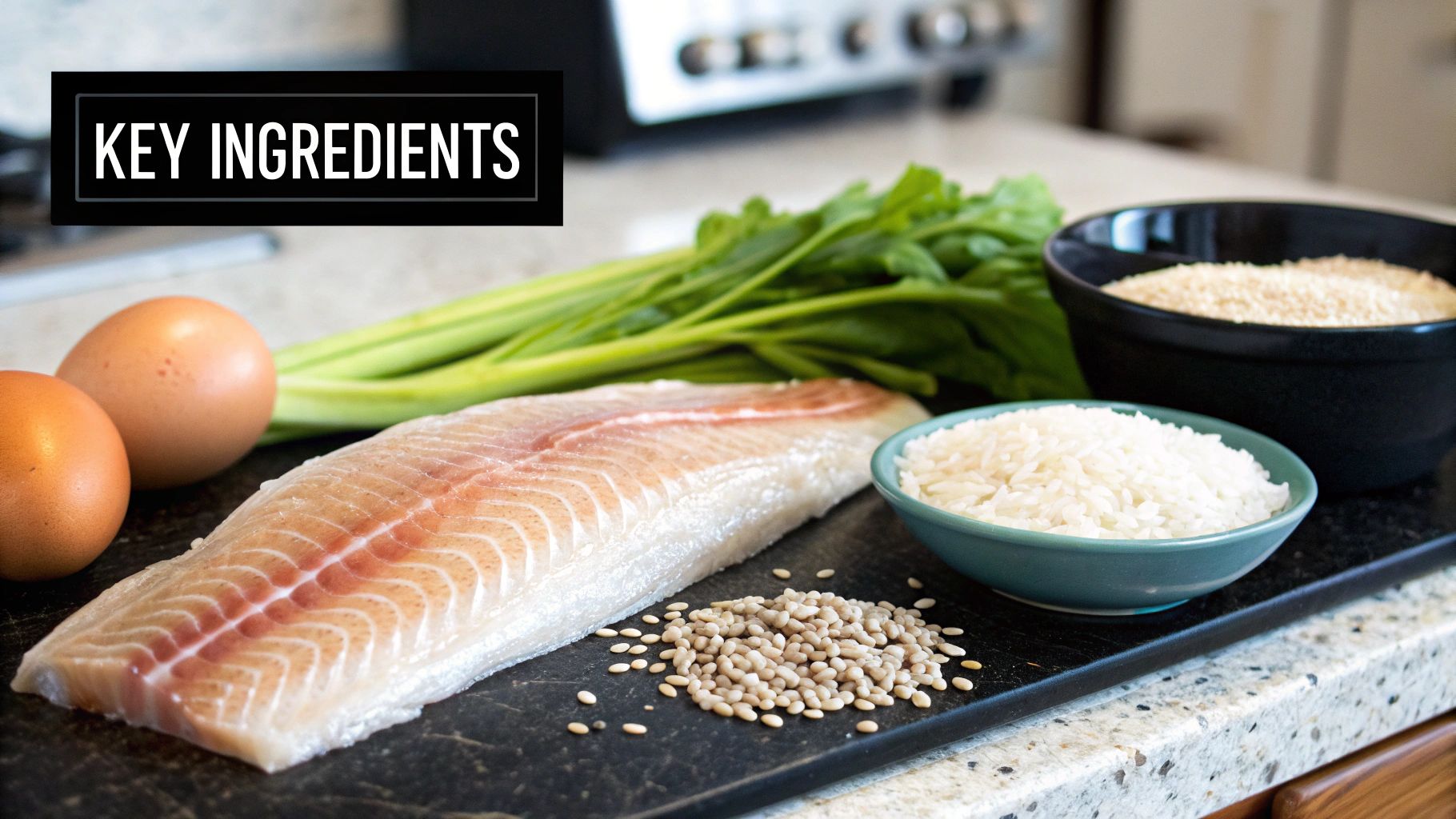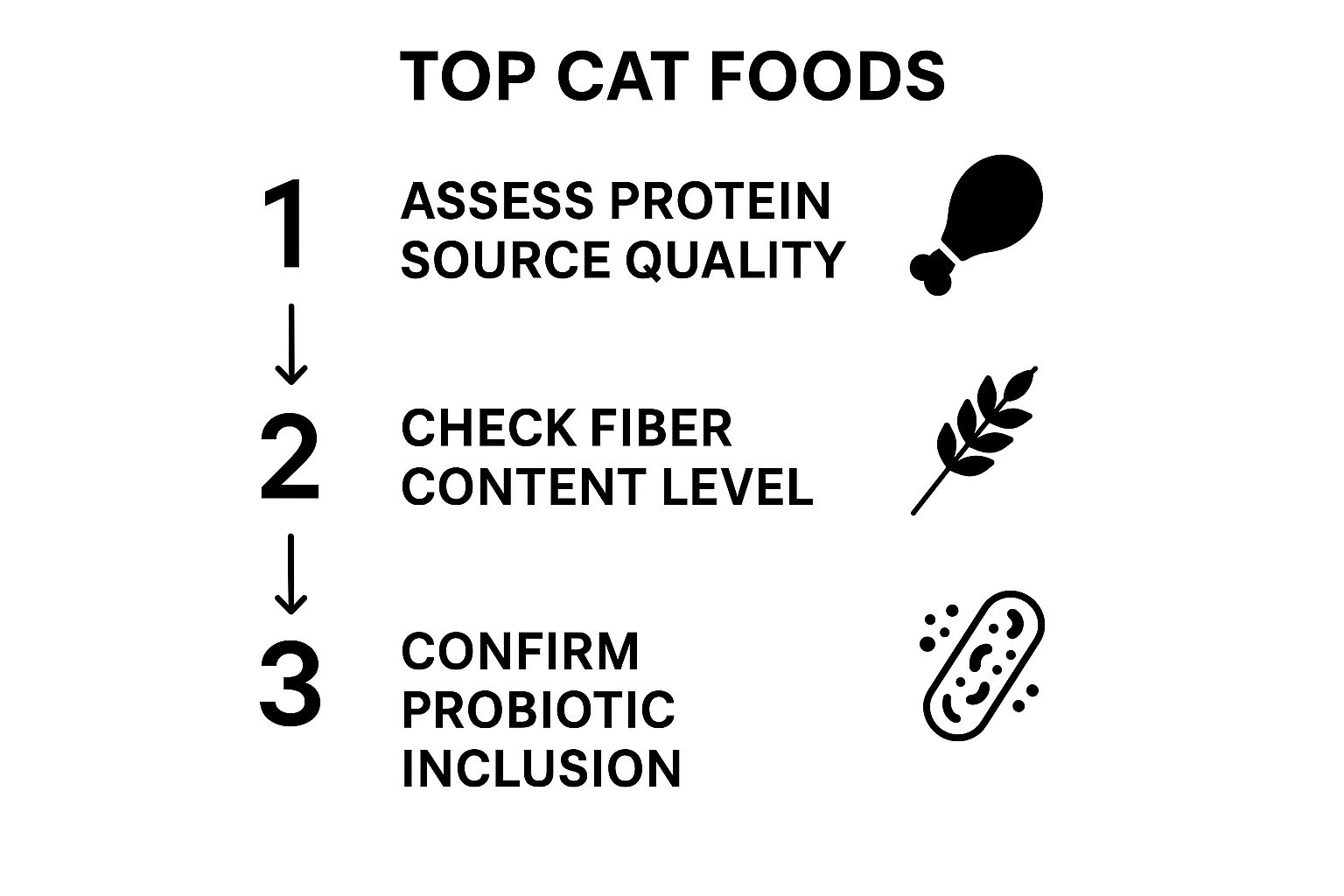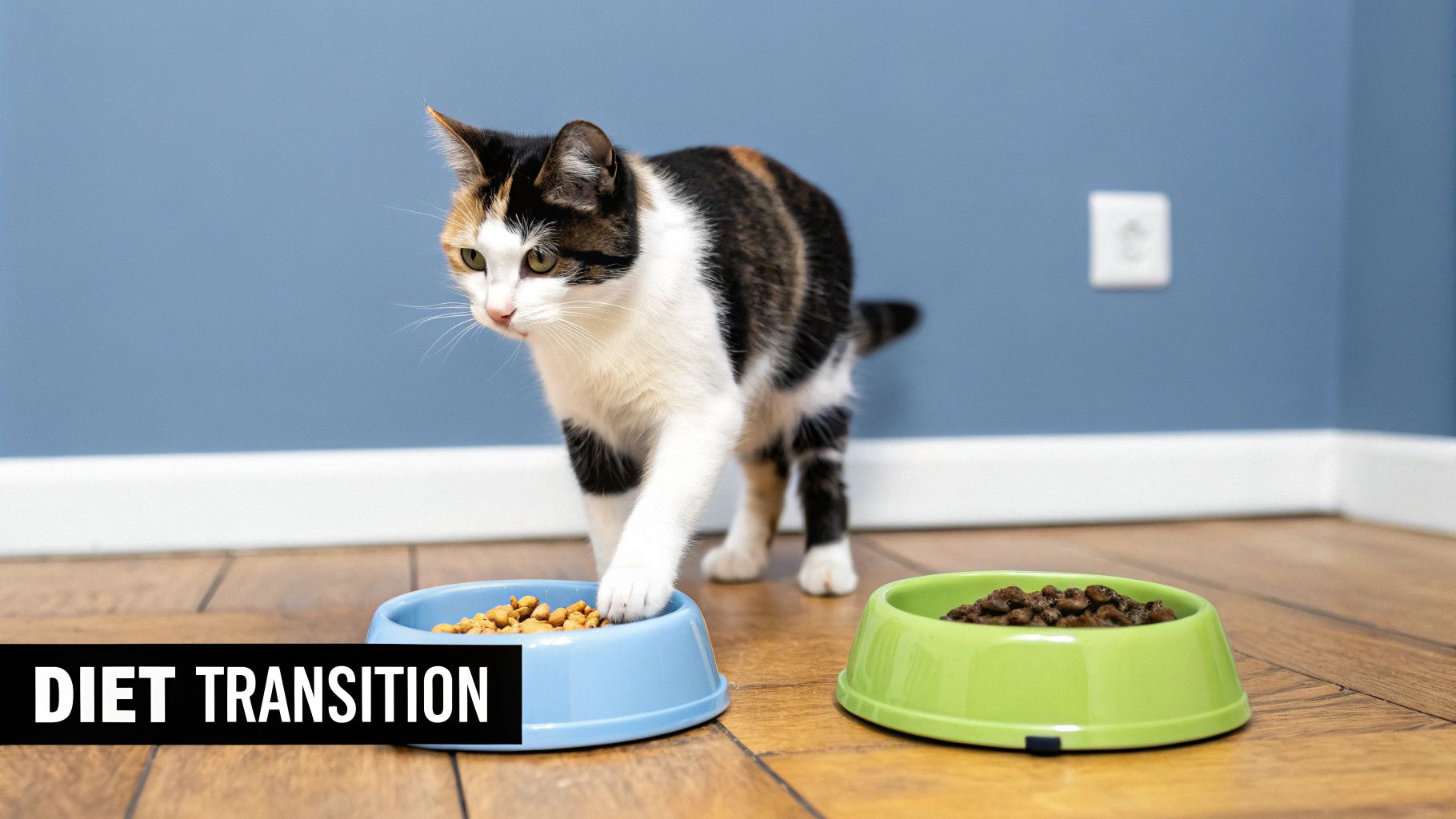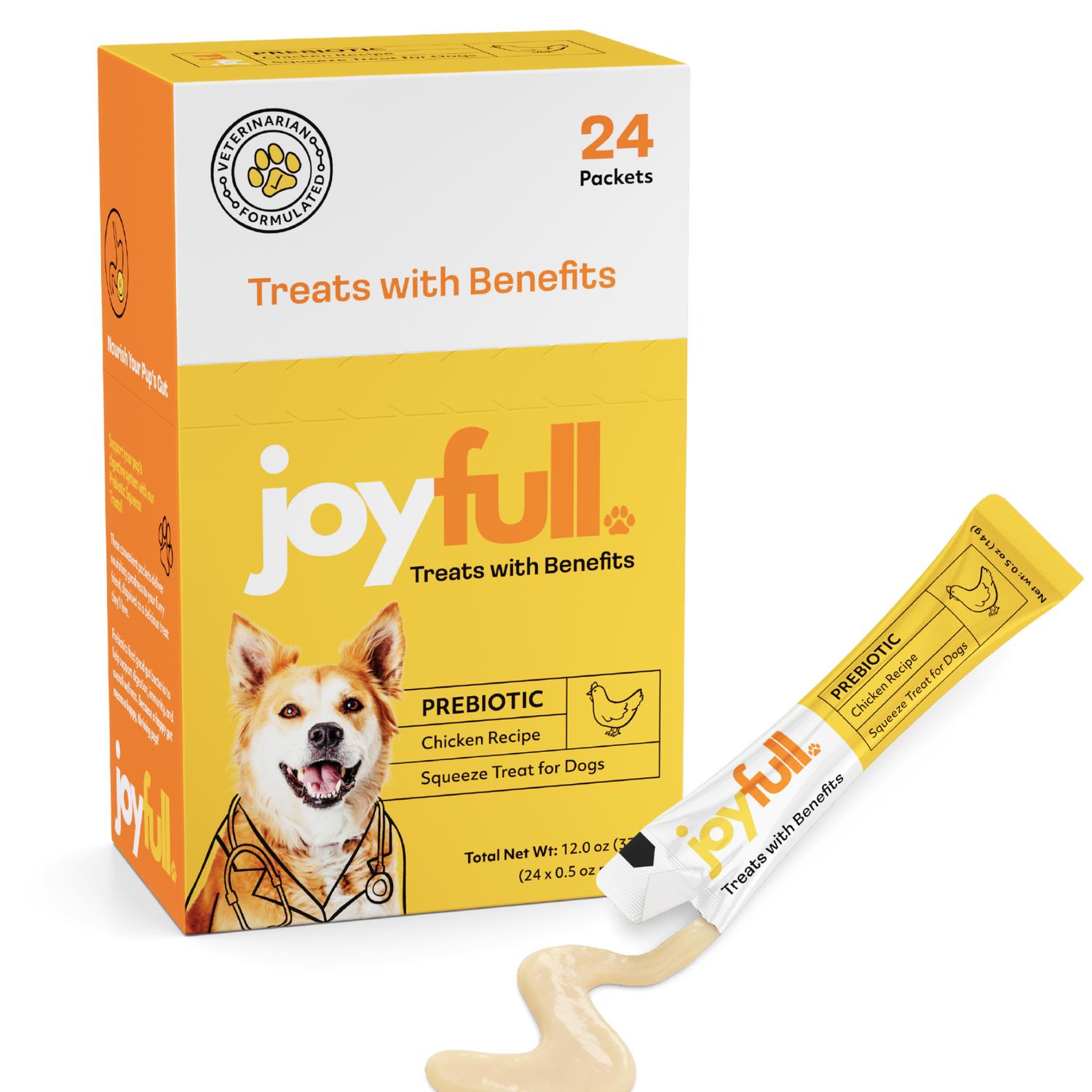
Find the Best Cat Food for Sensitive Stomach | Expert Tips
It’s a feeling many cat owners know all too well—that sinking worry when you realize something is just "off" with your cat. You might see occasional vomiting that you know isn't a hairball, or maybe the litter box is telling a story of consistently loose stools. These are often the first clues that your cat might have a sensitive stomach.
These digestive issues aren't just a mess to clean up; they're signs of real discomfort. Your cat can't tell you their stomach hurts, so they show you in other ways.
Recognizing the Signs of a Sensitive Stomach in Your Cat
https://www.youtube.com/embed/C_NP1um5vdg
The signs of a sensitive stomach can be surprisingly subtle, or they can be impossible to ignore. The key is to connect these behaviors to their diet, as food is so often the underlying cause. What you're looking for is a pattern, not just a single off day.
Common Symptoms of Digestive Upset
Keep an eye out for these classic indicators:
- Vomiting or Regurgitation: We all know hairballs are part of the deal. But frequent vomiting of undigested or partially digested food is a major red flag.
- Diarrhea or Loose Stools: Anything other than firm, well-formed stool on a consistent basis points to a problem in the digestive tract.
- Excessive Gas: A little toot now and then is one thing. If your cat is suddenly much more flatulent, their food probably isn't agreeing with them.
- Picky Eating or Loss of Appetite: Sometimes a cat will start avoiding their food bowl because they've learned to associate it with an upset stomach.
- Dull Coat and Poor Skin Condition: When a cat's gut is chronically unhappy, it can't absorb nutrients properly. This often shows up on the outside as a lackluster coat or flaky skin.
If this sounds familiar, you're not alone. This issue is becoming incredibly common, which has led to a major shift in the pet food world. The market for sensitive stomach cat food was valued at a staggering $1.2 billion in 2024 and is only expected to grow. This boom reflects a growing understanding among owners about the critical link between what's in the bowl and a cat's digestive health. You can find more details on these trends in in-depth industry analyses.
Why a Diet Change Is Your First, Best Move
Once you and your veterinarian have ruled out more serious medical conditions, changing your cat’s diet is the most powerful and direct way to bring them relief. The right food can make a world of difference, sometimes almost overnight.
For so many cats, digestive peace comes from simplifying their diet. The whole idea is to remove common triggers and give them nutrients in a form their body can actually use, which leads to less inflammation and better health from the inside out.
The best cat food for a sensitive stomach is often defined more by what it doesn't have than what it does. By choosing a formula with minimal, high-quality ingredients, you’re taking the most important step toward a happier, more comfortable cat.
A Quick Guide to Reading the Label
When you're standing in the pet food aisle, the sheer number of options can be overwhelming. To cut through the noise, focus on these key features.
Here is a quick reference table to help you identify the most important attributes when you're comparing bags and cans.
| Feature | Why It Matters for Sensitive Stomachs | Example Ingredients to Look For |
|---|---|---|
| Single Animal Protein | Reduces the chance of an allergic reaction or intolerance. It's much easier to pinpoint the trigger. | Deboned Chicken, Turkey, Duck, Rabbit |
| Limited Ingredients | "Less is more." Fewer ingredients mean fewer potential irritants for a sensitive digestive system. | Diets with 10 or fewer main ingredients. |
| Highly Digestible Carbs | Gentle on the stomach and provide necessary energy without causing GI distress. | Sweet Potato, Pumpkin, Peas |
| No Common Fillers/Allergens | Corn, wheat, soy, and artificial additives are frequent culprits behind digestive upset and inflammation. | Grain-free formulas; no "meat by-products" |
| Added Probiotics | These beneficial bacteria support a healthy gut microbiome, which is crucial for good digestion. | Lactobacillus acidophilus, Enterococcus faecium |
| Omega Fatty Acids | Help reduce inflammation in the gut and also promote healthy skin and a shiny coat. | Fish Oil, Flaxseed |
Think of this table as your cheat sheet. By looking for foods that check these boxes, you dramatically increase your odds of finding the perfect match for your cat's unique needs.
How to Decode Cat Food Labels Like an Expert

Walking down the pet food aisle can feel overwhelming. The packaging is designed to catch your eye with beautiful images of roasted meats and garden vegetables, but the real story is always on the back. Learning to read these labels is the most powerful skill you can develop when looking for the best cat food for a sensitive stomach.
It’s all about knowing what to look for. Once you do, you can confidently cut through the marketing fluff. The truth is found in three specific sections: the ingredient list, the guaranteed analysis, and the AAFCO nutritional adequacy statement.
Let's break down how to read each one like you've been doing it for years.
The First Five Ingredients Tell All
This is where you'll find the most revealing information. Ingredients are listed by weight, starting with the heaviest. Because of this, the first five ingredients paint a very clear picture of the food’s foundation.
For a cat with a tricky tummy, you want to see a high-quality, single-source animal protein right at the top. Look for specific, whole-food terms like "deboned chicken," "turkey," or "salmon." Be wary of vague language like "meat by-products" or "poultry meal." These generic terms can be a mystery mix of proteins from various animals, making it nearly impossible to pinpoint what’s causing the upset.
Here are a few common red flags to watch out for:
- Vague Proteins: Terms like "meat" or "animal digest" are too ambiguous.
- Common Fillers: Corn, wheat, and soy are often used to bulk up food but offer little nutritional value and are frequent culprits behind digestive issues.
- Artificial Additives: Unnecessary colors, flavors, and preservatives can easily irritate a sensitive gut.
Guaranteed Analysis and the AAFCO Statement
The guaranteed analysis panel gives you the breakdown of essential nutrients. It shows the minimum percentage of protein and fat and the maximum percentage of fiber and moisture. For a sensitive cat, a high-protein diet (ideally above 30% for dry food) and moderate fat levels are a good starting point. A healthy amount of fiber, around 5-8%, from gentle sources like pumpkin or beet pulp can also be incredibly beneficial for digestion.
Don't overlook the AAFCO statement. This small bit of text is your assurance that the food is "complete and balanced" for your cat's specific life stage, whether that's for "adult maintenance" or "growth" (for kittens). It's a seal of approval confirming the food provides all the core nutrients your cat needs to thrive.
The goal is simple: find a food with a short, understandable ingredient list led by a real protein. The less complicated the formula, the less likely it is to cause problems for a delicate digestive system.
It's clear that cat owners are demanding better. The global sensitive stomach cat food market was valued at around $7 billion in 2024, a testament to how many of us are focusing on our pets' digestive wellness. This consumer-driven shift is pushing brands to create cleaner, more effective formulas.
Getting a handle on reading labels is truly a game-changer. For an even deeper dive into what makes a great cat food, our guide on how to choose cat food is a fantastic resource. You'll go from feeling confused in the pet food aisle to feeling empowered, making choices based on solid facts, not just clever marketing.
Choosing the Right Formula: Wet vs. Dry Food

After you've pinpointed the right ingredients for your cat, you'll face the next big decision: food texture. The wet-versus-dry food debate is a classic one, but it takes on special importance when you’re dealing with a sensitive stomach. Both have their pros and cons, but for digestive health, one usually comes out on top.
For most cats with touchy tummies, wet food is the clear winner. The biggest reason is its high moisture content. Cats are famous for not drinking enough water, and even mild, chronic dehydration puts a real strain on their kidneys and digestive system. Wet food delivers essential hydration right in their dinner bowl.
On top of that, the soft, smooth texture of a pâté or a shredded-style food is just plain easier on the gut. It takes less work for their system to break down and digest, which often means better nutrient absorption and a much calmer digestive process.
The Power of Moisture and Simple Ingredients
Another point in wet food's favor is that it's often lower in carbohydrates than dry kibble. To make kibble, manufacturers have to use starchy binders to hold those little shapes together. For many cats, a diet high in carbs is a primary trigger for digestive upset. A high-protein, low-carb wet food is much closer to what a cat would naturally eat in the wild, and that shift alone can be a game-changer.
This isn’t just a fad. The demand for these specialized diets reflects a growing understanding of what our cats really need. In fact, the market for sensitive stomach cat food is on track to hit $2.5 billion by 2025. It’s a clear sign that countless cat owners are searching for these very solutions.
Key Takeaway: The high moisture in wet food is a huge plus for hydration and kidney health. Its softer texture and lower carb count also make it much easier for a sensitive stomach to handle.
Of course, this doesn't mean dry kibble is all bad. It's budget-friendly, convenient, and you can leave it out for cats who like to graze throughout the day. Certain kibbles are even formulated to help scrape tartar off teeth, offering a dental benefit.
Finding the Right Balance for Your Cat
So, what's the best choice? It really boils down to your individual cat and their specific needs.
Here are a few scenarios I've seen play out:
- For a cat with a history of urinary tract or kidney issues, the extra hydration from an all-wet-food diet is non-negotiable. It can make a world of difference.
- For a cat who wolfs down their food too quickly, a mixed-feeding approach can work wonders. Try serving their main meals as wet food but putting a small amount of dry kibble in a puzzle feeder to make them slow down.
- For a particularly fussy eater, sometimes the best food is simply the one they'll eat consistently without causing a flare-up. You have to pick your battles.
The goal isn't to pick a universal winner but to figure out what works for your cat. By understanding these differences, you're empowered to make a much more informed decision. And no matter which texture you go with, it’s vital to make sure it’s free from problematic additives. Checking a list of common cat food ingredients to avoid is always a smart final step.
A Gentle Plan for Switching Your Cat's Food
You’ve done the research and picked out what looks like the perfect food for your cat's sensitive stomach. Now comes the most important part: making the switch. I can't stress this enough—don't just swap the foods out cold turkey. That’s a surefire recipe for the exact digestive upset you're trying to fix.
The secret to a successful transition is patience. Cats are creatures of habit, right down to their gut bacteria. A slow, gradual switch over 7 to 10 days (sometimes longer!) gives their digestive system a fighting chance to adjust to the new ingredients.
The Slow and Steady Mixing Method
The idea is simple: you’ll gradually mix in the new food with the old, slowly tipping the scales until your cat is eating 100% of the new formula. Think of it as a gentle negotiation with their digestive tract.
Start small. I mean, really small. A good starting point is a mix of 25% new food to 75% old food. Stick with this ratio for at least two or three days. During this time, you're a detective. Watch how your cat eats, their energy levels, and—most importantly—what's happening in the litter box.
If all systems are go (no vomiting, solid stool, happy kitty), you can proceed. If not, don't panic. Just dial back the amount of new food and give it more time.
A Pro Tip From Experience: Is your cat snubbing the new mixture? It happens. Some cats are so sensitive to new smells they'll reject the bowl immediately. If this is your cat, try adding just a tiny sprinkle of the new food—maybe only 10% of the meal—and mix it in thoroughly. A little bit of persistence here goes a long way.
Watching for Signs of Success (or Setbacks)
Your cat's litter box tells the truest story. Throughout the transition, you want to see well-formed, solid stools. If you notice things getting soft or turning into full-blown diarrhea, you’re moving too fast.
When that happens, simply revert to the previous ratio that worked (where their stool was normal) and hold there for a few extra days before trying to increase the new food again. It’s a marathon, not a sprint.
As you move through this process, keep the fundamentals in mind. This flowchart gives a great visual summary of what makes a good sensitive stomach formula in the first place.

It all starts with a high-quality animal protein, followed by the right kind of fiber, and beneficial extras like probiotics to build a healthy gut from the inside out.
Once your cat has successfully handled the initial mix for a few days, you can start following a more structured schedule. Here is a sample plan that works for most cats.
Sample 10-Day Cat Food Transition Schedule
This day-by-day guide provides a framework for gradually introducing new food. Remember, this is a template—adjust the timeline based on your cat’s individual response.
| Day(s) | Old Food Ratio | New Food Ratio | What to Watch For |
|---|---|---|---|
| 1-3 | 75% | 25% | Changes in appetite, vomiting, stool consistency. |
| 4-6 | 50% | 50% | Continued monitoring of stool. Look for firmness. |
| 7-9 | 25% | 75% | Check for any delayed reactions like skin itchiness or gas. |
| 10+ | 0% | 100% | Ensure stool remains solid and your cat is eating well. |
Again, this 10-day schedule is just a guideline. I've worked with cats who needed a full two weeks, or even a month, to make the switch comfortably. The most important thing is to listen to your cat’s body. A successful, peaceful transition is the first step toward long-term digestive health and a happier cat.
Lifestyle Changes That Support a Healthy Gut

While finding the right food is a huge piece of the puzzle, don't underestimate the power of a supportive home environment. A truly happy gut isn't just about what goes into the bowl. Simple adjustments to your cat's daily life can significantly reduce their stress and help their new diet work even better.
Think about it from your cat's point of view. For them, anxiety and stress often show up as physical problems, and the digestive system is one of the first places to feel it. A chaotic feeding area or unpredictable meal times can create enough anxiety to trigger vomiting or diarrhea, even if the food itself is perfect.
This is where a calm, consistent routine becomes your most powerful tool. Feeding your cat at the same times each day in a quiet, low-traffic spot gives them a sense of security that can have a calming effect on their entire body.
Encourage Healthy Eating Habits
Does your cat have a "scarf and barf" problem? It's a surprisingly common scenario: they inhale their food in under a minute, only to regurgitate it all a few minutes later. This is usually caused by eating way too fast, not by a problem with the food's ingredients.
This is exactly what puzzle feeders and slow-feeder bowls were designed for. These clever tools turn mealtime into a more engaging activity, making your cat slow down and "work" for their food. Not only does this stop them from eating too quickly, but it also provides a much-needed mental workout.
A puzzle feeder does more than just slow down a fast eater. It taps into your cat's natural hunting instincts, reducing boredom and the stress that can come with it. A less-stressed cat is often a cat with a happier gut.
Another strategy is to serve smaller, more frequent meals throughout the day instead of one or two large ones. This approach is much easier on their digestive tract and helps keep their energy levels stable.
Hydration and Play Are Not Optional
Proper hydration is non-negotiable for digestive health. A dehydrated gut is a sluggish one, so make sure your cat always has access to fresh, clean water. If they seem reluctant to drink, try a water fountain—the moving water often entices cats to drink more.
Gentle activity is also a fantastic aid for digestion. A short play session with a favorite toy about an hour after they eat can help get things moving through their gastrointestinal tract smoothly.
Even the treats you choose can make a difference. When you're rewarding your cat, stick to simple, single-ingredient options that won't upset their stomach. You can find some great ideas for healthy snacks for cats that complement their sensitive-stomach diet.
By pairing the right food with these simple lifestyle tweaks, you’re taking a holistic approach that supports your cat's well-being from every angle.
Navigating Common Questions About Your Cat's New Diet
Even with the best plan, you’re bound to have some questions. It’s totally normal. When you’re trying to get your cat’s health back on track, you want to feel confident you’re doing the right thing. So, let's walk through some of the most common things that come up when switching to a sensitive stomach diet.
How Long Before I See a Real Difference?
This is where your patience will be tested, I promise you. While you might get lucky and see firmer stools in just a few days, that’s not the norm. Realistically, it takes a full 4 to 8 weeks for a cat's digestive system to calm down, heal, and fully adjust to a new food.
Deeper issues, like a dull coat or flaky skin, can take even longer to resolve as their body finally starts getting the nutrients it was missing. The key is to stick with one single food for that entire 8-week period unless their symptoms are getting noticeably worse. I always recommend keeping a simple daily log—just a few notes on appetite, energy, and what you see in the litter box. It helps you see the small, gradual improvements you might otherwise miss.
Is "Grain-Free" the Magic Bullet for a Sensitive Stomach?
This is probably one of the biggest myths in pet food, and the short answer is no, not at all. While some cats are sensitive to grains, true grain allergies are actually quite rare. It's far more common for cats to have a problem with a specific animal protein, like chicken or beef.
Your goal shouldn't be just to eliminate grains. It should be to find a high-quality, limited-ingredient diet that cuts out your cat’s specific trigger. Many grain-free foods just swap grains for other high-starch fillers like potatoes or tapioca, which can create a whole new set of digestive upsets. Always look at the entire ingredient list, not just whether it says "grain-free" on the bag.
The most effective approach is to identify the specific ingredient that upsets your cat's stomach. A food built around a novel protein (one they've never eaten before) is often a better starting point than simply going grain-free.
Can My Cat Still Have Treats?
Yes! Treats are a huge part of our bond with our cats, and you don't have to give them up. You just have to become a much smarter treat-shopper. Most commercial treats are loaded with the exact same fillers, mystery proteins, and artificial junk that caused the problem in the first place. Giving the wrong treat can undo all of your hard work.
Here’s how to give treats without derailing the diet:
- Stick to single-ingredient treats. Things like freeze-dried salmon or duck are fantastic, as long as that protein matches what's in their main diet.
- Use their kibble. Honestly, a few pieces of their new special food often work just as well as a reward. It's a "treat" to them without introducing anything new.
- Introduce new treats slowly. Just like with their food, give any new treat a trial period of at least a week to make sure it doesn't cause a reaction.
When Is It Time to Call the Vet?
While a diet change can be incredibly effective, it’s not a cure-all, and it’s critical to know when you need professional help. Your first step should always be a vet visit to rule out serious medical issues that can look just like a food sensitivity.
Get to the vet right away if your cat shows any of these signs:
- Severe symptoms like non-stop vomiting or bloody diarrhea.
- Sudden lethargy or a big change in their personality.
- Any noticeable weight loss.
- Digestive problems that don't get better after a careful, complete food transition.
Your veterinarian can diagnose and treat conditions like Inflammatory Bowel Disease (IBD), pancreatitis, or even parasites. These require medical intervention that goes far beyond what even the best cat food for a sensitive stomach can fix on its own.
At Joyfull, we believe a healthy gut is the foundation of a happy life for your pet. We craft our formulas with clean, high-quality proteins and scientifically-backed ingredients to provide real digestive support. Discover the difference that a genuinely beneficial food can make for your cat. Learn more about our no-BS approach to pet wellness.

